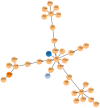PspA Diversity, Serotype Distribution and Antimicrobial Resistance of Invasive Pneumococcal Isolates from Paediatric Patients in Shenzhen, China
- PMID: 33469319
- PMCID: PMC7810716
- DOI: 10.2147/IDR.S286187
PspA Diversity, Serotype Distribution and Antimicrobial Resistance of Invasive Pneumococcal Isolates from Paediatric Patients in Shenzhen, China
Abstract
Introduction: To determine the phenotypes and genotypes of invasive Streptococcus pneumoniae (S. pneumoniae), 108 strains were isolated from paediatric patients with invasive pneumococcal diseases (IPDs) in Shenzhen from 2014 to 2018.
Methods: Serotype profiles were defined by multiplex PCR of the capsule gene. Pneumococcal surface protein A (PspA) classification was performed through pspA gene sequencing. Antimicrobial resistance was examined by broth microdilution. Multilocus sequence typing (MLST) was determined based on next-generation sequencing data.
Results: Eighty-one S. pneumoniae of 17 serotypes were finally collected. The coverage of the 13-conjugated polysaccharide vaccine (PCV13) was 88.9%. After the introduction of PCV13, the nonvaccine serotypes were added by serotypes 15b, 16F and 20. Vaccine serotype 3 increased by four serious cases. The pspA family 1 and pspA family 2 are predominant. The multiple drug resistance rate is 91.3%. None of the nonmeningitis isolates were resistant to penicillin, while 98.8% of all the isolates were resistant to erythromycin.
Discussion: This work characterizes the molecular epidemiology of invasive S. pneumoniae in Shenzhen. Continued surveillance of serotype distribution and antimicrobial susceptibility is necessary to alert antibiotic-resistant nonvaccine serotypes and highly virulent serotypes.
Keywords: PspA family; Streptococcus pneumoniae; antimicrobial resistance; invasive pneumococcal disease; serotype.
© 2021 Jiang et al.
Conflict of interest statement
The authors declare that there is no conflict of interest regarding the publication of this paper.
Figures




Similar articles
-
Serotype Distribution, Antimicrobial Susceptibility, and Multilocus Sequencing Type (MLST) of Streptococcus pneumoniae From Adults of Three Hospitals in Shanghai, China.Front Cell Infect Microbiol. 2019 Nov 27;9:407. doi: 10.3389/fcimb.2019.00407. eCollection 2019. Front Cell Infect Microbiol. 2019. PMID: 31828048 Free PMC article.
-
The changing phenotypes and genotypes of invasive pneumococcal isolates from children in Shenzhen during 2013-2017.Vaccine. 2019 Nov 20;37(49):7248-7255. doi: 10.1016/j.vaccine.2019.09.069. Epub 2019 Oct 18. Vaccine. 2019. PMID: 31635974
-
Molecular Characterization Based on Whole-Genome Sequencing of Streptococcus pneumoniae in Children Living in Southwest China During 2017-2019.Front Cell Infect Microbiol. 2021 Nov 2;11:726740. doi: 10.3389/fcimb.2021.726740. eCollection 2021. Front Cell Infect Microbiol. 2021. PMID: 34796125 Free PMC article.
-
CIRCULATING CLONAL COMPLEXES AND SEQUENCE TYPES OF STREPTOCOCCUS PNEUMONIAE SEROTYPE 19A WORLDWIDE: THE IMPORTANCE OF MULTIDRUG RESISTANCE: A SYSTEMATIC LITERATURE REVIEW.Expert Rev Vaccines. 2021 Jan;20(1):45-57. doi: 10.1080/14760584.2021.1873136. Epub 2021 Feb 17. Expert Rev Vaccines. 2021. PMID: 33507135
-
Serotype distribution and antimicrobial resistance of Streptococcus pneumoniae causing invasive diseases in China: a meta-analysis.BMC Pediatr. 2019 Nov 11;19(1):424. doi: 10.1186/s12887-019-1722-1. BMC Pediatr. 2019. PMID: 31711442 Free PMC article.
Cited by
-
Characterization of Streptococcus pneumoniae Macrolide Resistance and Its Mechanism in Northeast China over a 20-Year Period.Microbiol Spectr. 2022 Oct 26;10(5):e0054622. doi: 10.1128/spectrum.00546-22. Epub 2022 Aug 8. Microbiol Spectr. 2022. PMID: 35938873 Free PMC article.
-
Intranasal influenza-vectored vaccine expressing pneumococcal surface protein A protects against Influenza and Streptococcus pneumoniae infections.NPJ Vaccines. 2024 Dec 19;9(1):246. doi: 10.1038/s41541-024-01033-5. NPJ Vaccines. 2024. PMID: 39702744 Free PMC article.
-
Prevalence of Streptococcus pneumoniae serotypes causing pneumococcal diseases in the Chinese Mainland: A systematic review and meta-analysis.Hum Vaccin Immunother. 2024 Dec 31;20(1):2416763. doi: 10.1080/21645515.2024.2416763. Epub 2024 Dec 4. Hum Vaccin Immunother. 2024. PMID: 39631045 Free PMC article.
-
A Jack of All Trades: The Role of Pneumococcal Surface Protein A in the Pathogenesis of Streptococcus pneumoniae.Front Cell Infect Microbiol. 2022 Feb 2;12:826264. doi: 10.3389/fcimb.2022.826264. eCollection 2022. Front Cell Infect Microbiol. 2022. PMID: 35186799 Free PMC article. Review.
References
LinkOut - more resources
Full Text Sources
Other Literature Sources

